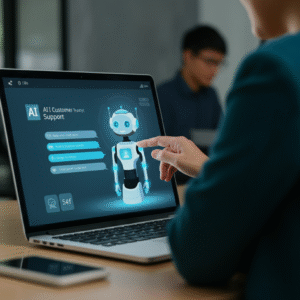
Introduction
Artificial intelligence is no longer an exclusive tool for corporate giants. Small and medium-sized enterprises (SMEs) are increasingly adopting AI to level the playing field, enhance productivity, and drive significant growth. By automating routine tasks, generating data-driven insights, and personalizing customer experiences, AI empowers smaller businesses to operate with the efficiency and scale of larger competitors. This shift is not about replacing human ingenuity but augmenting it, allowing teams to focus on strategic initiatives that truly matter.
This article explores real-world case studies of SMEs that have successfully integrated AI to boost efficiency. We will dive into specific examples from various industries, showcasing how these companies overcame challenges and achieved measurable results. You will discover practical applications, key takeaways, and a clear roadmap for how your own business can begin its AI journey. From retail and manufacturing to marketing and customer support, these stories prove that AI is an accessible and powerful lever for any SME ready to innovate.
The Growing Imperative for AI Efficiency in Small Business
Before diving into the case studies, it’s important to understand why AI efficiency is becoming a critical priority for SMEs. In a competitive market, efficiency is directly linked to profitability and sustainability. Wasted time, manual errors, and operational bottlenecks can drain resources and limit growth potential. SMEs often operate with leaner teams and tighter budgets, making every minute and every dollar count.
This is where AI for SMEs makes a tangible difference. Unlike traditional software, AI systems can learn, adapt, and make autonomous decisions. They handle high-volume, repetitive tasks with speed and accuracy far beyond human capability. This automation frees up valuable employees to engage in creative problem-solving, customer relationship building, and strategic planning—activities that drive long-term value.
Key areas where AI drives efficiency for SMEs include:
- Process Automation: Handling routine tasks like data entry, scheduling, and report generation.
- Data Analysis: Transforming raw data into actionable insights for better decision-making.
- Customer Interaction: Providing 24/7 support and personalized engagement through chatbots and AI-driven communication.
- Resource Optimization: Improving inventory management, supply chain logistics, and production scheduling.
The following AI case studies illustrate these benefits in action, providing a blueprint for how SMEs can harness this technology to thrive.
AI Case Study 1: Transforming Retail with Smart Inventory Management
The retail sector is fiercely competitive, and for SMEs, managing inventory effectively can be the difference between success and failure. Overstocking ties up capital, while stock outs lead to lost sales and unhappy customers.

Company: Bella Boutique, an online fashion store in the UK.
The Challenge: Bella Boutique was struggling with manual inventory tracking across its website, social media shops, and a small physical storefront. The owner spent hours each week reconciling stock levels, which often resulted in errors. Frequent stockouts on popular items damaged customer loyalty, while slow-moving products gathered dust, leading to costly markdowns. The lack of a centralized system made it nearly impossible to forecast demand accurately.
The AI Solution: The company implemented an AI-driven inventory management system. This solution integrated seamlessly with its existing sales channels (Shopify and social commerce platforms). The AI algorithm analyzed historical sales data, real-time purchasing trends, customer browsing behavior, and even external factors like seasonal demand and supplier lead times. It provided predictive insights into which products would sell best and when to reorder.
Key Features of the AI Implementation:
- Demand Forecasting: The AI predicted future sales with high accuracy, suggesting precise order quantities to avoid both overstocking and understocking.
- Automated Reordering: The system automatically generated purchase orders when stock levels for popular items reached a predefined threshold.
- Personalized Recommendations: On the e-commerce site, an AI engine analyzed individual customer data to suggest products they were likely to buy, increasing cross-selling and upselling opportunities.
The Results:
- 30% Reduction in Overstocking: By ordering based on predictive analytics, the boutique minimized capital tied up in unsold goods.
- 75% Decrease in Manual Tracking Time: Automation freed the owner to focus on marketing, customer engagement, and sourcing new products.
- 40% Increase in Repeat Purchases: Personalized product recommendations improved the customer experience and encouraged loyalty.
Actionable Takeaway: Retail SMEs can leverage affordable AI-powered inventory tools, many of which are available as apps or plugins for popular e-commerce platforms like Shopify or BigCommerce. Start by identifying your most significant inventory challenges and look for a solution that offers robust demand forecasting and automation capabilities.
AI Case Study 2: Predictive Maintenance in Manufacturing
For manufacturing SMEs, equipment downtime is a major threat to productivity and profitability. A single machine failure can halt an entire production line, causing costly delays, missed deadlines, and expensive emergency repairs.

Company: TechParts Manufacturing, a German SME specializing in precision-engineered components.
The Challenge: TechParts Manufacturing operated on a reactive maintenance schedule. Technicians would only fix machinery after it broke down. This approach led to frequent, unplanned downtime that disrupted production schedules and strained client relationships. The annual cost of emergency repairs and lost production was a significant drain on the company’s bottom line.
The AI Solution: The company partnered with a technology firm to integrate AI-powered predictive maintenance. They installed IoT (Internet of Things) sensors on their critical machinery to collect real-time data on temperature, vibration, energy consumption, and other operational metrics. This data was fed into an AI model that was trained to recognize the subtle patterns preceding a mechanical failure.
How the AI System Worked:
- Real-Time Monitoring: The sensors continuously streamed data to a central AI platform.
- Anomaly Detection: The AI algorithm identified deviations from normal operating parameters, flagging potential issues long before a breakdown occurred.
- Failure Prediction: By analyzing historical failure data, the model could predict when a specific component was likely to fail, allowing the maintenance team to schedule repairs proactively.
- Automated Alerts: When the system predicted a future failure, it sent an automated alert to the maintenance manager with details on the specific machine and the component at risk.
The Results:
- 40% Reduction in Unplanned Downtime: Proactive maintenance allowed the company to schedule repairs during planned shutdowns, maximizing operational uptime.
- €60,000 in Annual Maintenance Savings: The shift from emergency repairs to planned maintenance significantly reduced costs for parts and labor.
- Improved Production Scheduling Accuracy: With more reliable machinery, the company could commit to deadlines with greater confidence, improving client satisfaction.
Actionable Takeaway: Manufacturing SMEs don’t need a massive budget to start with predictive maintenance. Begin by identifying one or two critical machines and equip them with affordable IoT sensors. Use an AI platform that offers a user-friendly dashboard to monitor equipment health and receive alerts. This “start small, scale smart” approach proves the ROI before a full-scale rollout.
AI Case Study 3: 24/7 Customer Support Without Extra Staff
Delivering exceptional customer service is a key differentiator for SMEs. However, providing round-the-clock support can be prohibitively expensive, especially for businesses with a growing global client base.

Company: FinPro Services, a financial consultancy in Singapore.
The Challenge: FinPro Services had a small but dedicated customer support team that was overwhelmed with inquiries. With clients in different time zones, the 9-to-5 support window was insufficient. Response times were slow, leading to client frustration. The team was spending most of its day answering repetitive questions about services, fees, and appointment scheduling, leaving little time for high-value consulting work.
The AI Solution: The firm deployed a sophisticated AI chatbot on its website and client portal. Using the ChatGPT API, the chatbot was trained on the company’s entire knowledge base, including service descriptions, FAQs, case studies, and policy documents. It was designed to handle a wide range of tasks without human intervention.
Capabilities of the AI Chatbot:
- Instant FAQ Answering: The chatbot provided immediate, accurate answers to common questions 24/7.
- Lead Qualification: It engaged with new website visitors, asking qualifying questions about their needs and budget to identify promising leads.
- Automated Appointment Scheduling: The chatbot integrated with the consultants’ calendars (via Google Calendar) to book meetings directly with qualified leads, eliminating back-and-forth emails.
- Seamless Human Handoff: For complex or sensitive inquiries, the chatbot could seamlessly transfer the conversation, along with its full context, to a human agent during business hours.
The Results:
- Response Times Cut from Hours to Seconds: Clients received instant assistance, dramatically improving their experience.
- Freed Up Two Full-Time Employees: The support team was able to transition from answering repetitive questions to focusing on in-depth client strategy and relationship management.
- 25% Boost in Client Satisfaction Ratings: Faster, more efficient service led to higher Net Promoter Scores (NPS) and positive reviews.
Actionable Takeaway: AI chatbots have become incredibly accessible and affordable. SMEs can use no-code platforms to build and deploy a powerful chatbot in a matter of days. Start by identifying the top 10-20 most frequently asked questions and use them to train your bot. This simple first step can provide an immediate boost in AI efficiency.
AI Case Study 4: Smarter Marketing with Data-Driven Decisions
Many SMEs struggle to achieve a positive return on investment (ROI) from their digital marketing efforts. Generic campaigns and poor audience targeting can lead to wasted ad spend and low conversion rates. AI provides the tools to move from guesswork to precision.

Company: GreenBite Foods, a Canadian organic snack brand.
The Challenge: GreenBite Foods was running digital ad campaigns on platforms like Facebook and Google, but their results were disappointing. Their targeting was broad, and they had little insight into which customer segments were most profitable. The marketing team was manually analyzing campaign data, a time-consuming process that often yielded inconclusive results.
The AI Solution: The company adopted an AI-powered marketing analytics platform. This tool connected to their ad accounts, website analytics (Google Analytics), and customer relationship management (CRM) system. It centralized all marketing data and used machine learning algorithms to uncover hidden patterns and opportunities.
How AI Transformed Their Marketing:
- Advanced Audience Segmentation: The AI analyzed customer demographics, purchase history, and online behavior to identify high-value audience clusters that the human team had missed.
- Automated Ad Optimization: The platform automatically adjusted ad bids, budgets, and creative combinations in real-time to maximize conversions and minimize cost-per-acquisition (CPA).
- Predictive Analytics for Churn: The AI identified customers at risk of churning and suggested proactive re-engagement campaigns, such as personalized offers or content.
- Clear Performance Dashboards: Instead of complex spreadsheets, the AI generated simple, visual reports that highlighted key performance indicators (KPIs) and provided plain-language insights (e.g., “Your campaign targeting young professionals is performing 50% above average”).
The Results:
- 35% Improvement in Conversion Rate: By targeting the right audiences with the right message, their campaigns became far more effective.
- 22% Reduction in Wasted Ad Spend: The AI automatically paused underperforming ads and reallocated the budget to top-performers.
- Identified Top-Performing Audience Clusters in One Week: What would have taken months of manual analysis, the AI accomplished in days.
Actionable Takeaway: SMEs can start using AI in marketing with tools they may already have. Google Ads and Facebook Ads have built-in AI features for audience targeting and bid optimization. For deeper insights, consider affordable third-party AI analytics platforms that integrate with your existing marketing stack. The key is to let data, not intuition, drive your marketing decisions.
AI Case Study 5: Personalized Learning in Education & Training
The “one-size-fits-all” model of education is becoming obsolete. Students learn at different paces and have unique needs. AI is enabling educational SMEs to deliver personalized learning experiences at scale, improving engagement and outcomes.

Company: SkillBridge Academy, an online training provider in India.
The Challenge: SkillBridge Academy offered a range of professional development courses, but they suffered from a low student completion rate. The rigid course structure didn’t cater to individual learning styles or prior knowledge levels. Advanced students became bored, while struggling learners fell behind, leading to high drop-out rates. Instructors were also burdened with manually grading a large volume of assessments.
The AI Solution: The academy implemented an AI-powered Learning Management System (LMS). This platform used AI algorithms to create adaptive and personalized learning journeys for each student.
Features of the AI-Powered Learning Platform:
- Personalized Learning Paths: At the start of a course, students took a diagnostic quiz. The AI analyzed the results to create a custom curriculum, allowing advanced learners to skip introductory modules and providing extra resources for those needing more support.
- Adaptive Assessments: Quizzes and tests were tailored to each learner’s progress. If a student struggled with a concept, the AI would provide additional practice questions and remedial content.
- Automated Grading and Feedback: The AI automatically graded multiple-choice questions and even provided instant feedback on short-answer responses using natural language processing (NLP).
- Instructor Dashboard: The platform gave instructors a high-level view of class performance, highlighting students who were falling behind and topics that the entire cohort found challenging.
The Results:
- Student Completion Rate Rose from 58% to 89%: Personalized paths kept students engaged and motivated.
- 40% Reduction in Instructor Workload: Automated grading freed up instructors to focus on mentoring students and improving course content.
- Enhanced Learning Outcomes: Students demonstrated a deeper understanding of the material, as evidenced by their performance on final projects.
Actionable Takeaway: For SMEs in the education or corporate training space, investing in an AI-driven LMS can be a game-changer. Look for platforms that emphasize adaptive learning and personalization. Even without a full-fledged AI system, you can use AI tools to generate quiz questions, create lesson summaries, or personalize feedback.
The Broader Impact: Common Threads in AI Success Stories
These AI case studies, spanning diverse industries, reveal several common themes about how AI boosts efficiency for SMEs:
- Automation of Repetitive Tasks: In every case, AI took over mundane, time-consuming work—from inventory tracking to answering FAQs. This consistently freed up human teams to focus on strategic, high-impact activities.
- Data-Driven Decision-Making: AI transforms data from a passive resource into an active guide. Whether predicting machine failures or segmenting marketing audiences, AI provides the clear, actionable insights needed for smarter business decisions.
- Enhanced Scalability: AI allows SMEs to scale their operations without a proportional increase in staff or resources. A chatbot can handle thousands of conversations simultaneously, and an AI marketing platform can manage hundreds of campaigns. This scalability is key to competing with larger enterprises.
- Improved Customer and Employee Experience: Efficiency gains are not just about cutting costs. Faster service, personalized interactions, and empowering employees with better tools lead to higher satisfaction for everyone involved.

How to Start Your AI Journey as an SME
The prospect of adopting AI can seem daunting, but it doesn’t have to be. By taking a methodical and strategic approach, any SME can begin to reap the benefits of AI efficiency.
Step 1: Identify Your Biggest Pain Points
Don’t adopt AI for the sake of technology. Start by identifying the most significant bottlenecks or repetitive processes in your business. Is it manual data entry? Inefficient scheduling? Poor marketing ROI? Focus on a real business problem that needs solving.
Step 2: Start Small with Affordable Tools
You don’t need a team of data scientists to get started. There is a growing ecosystem of user-friendly and affordable AI tools designed specifically for SMEs. Consider:
- AI-Powered Communication: Use chatbots like Tidio or the ChatGPT API for customer support.
- Automation Platforms: Tools like Zapier AI or Pabbly Connect can automate workflows between the apps you already use.
- Content Creation: Leverage AI writing assistants to help with marketing copy, blog posts, or social media updates.
Step 3: Measure Your Results
Once you implement a new AI tool, it’s crucial to measure its impact. Track key metrics related to the problem you set out to solve. This could be time saved (in hours per week), costs reduced, productivity improved (e.g., number of support tickets resolved), or revenue increased. Proving the ROI of your initial project will build momentum and secure buy-in for future initiatives.
Step 4: Scale Gradually
After proving the value of your first AI project, you can start to explore more advanced integrations. This could involve implementing a predictive analytics model for sales forecasting, deploying an AI-powered CRM, or integrating AI across multiple departments. The key is to scale in a controlled and deliberate manner, building on each success.
Conclusion: The Future of SME Efficiency is Here
Artificial intelligence is no longer a futuristic concept reserved for tech behemoths; it is a present-day reality that is unlocking unprecedented levels of efficiency and growth for SMEs. The case studies explored in this article demonstrate that with the right strategy, any small or medium-sized business can leverage AI to automate processes, make smarter decisions, and deliver superior customer experiences.
From the retail shop optimizing its stock to the manufacturer predicting its next maintenance need, the message is clear: the businesses that will lead tomorrow are those that embrace intelligent automation today. The journey begins not with a massive investment, but with a simple question: “What is the most repetitive, time-consuming task in my business?” The answer is your first step toward a more efficient, scalable, and competitive future.
Ready to explore how AI can transform your business operations? Start by identifying your key challenges and investigate the accessible AI solutions designed to solve them. Your journey to greater efficiency begins now.





Leave a Reply